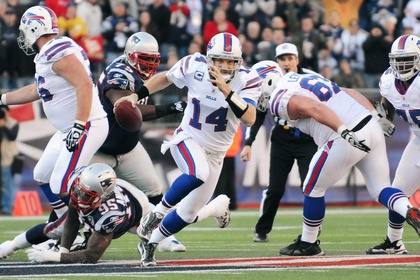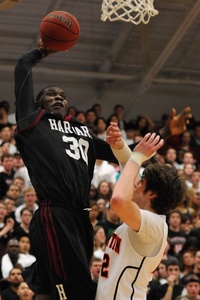After Ryan Fitzpatrick ’05 and the Buffalo Bills captured a dramatic Week 3 victory over their divisional foe and frontrunner, the New England Patriots, the 3-0 Bills seemed poised to rewrite recent history and threaten the traditional AFC East powers.
The game featured a little “Fitzmagic.” With big plays and precision passing, Fitzpatrick led his team down the field for two scores in the fourth quarter en route to victory. Fitzpatrick’s play was bolstered by a stingy Bills’ defense, which forced four interceptions and returned one for a touchdown.
But as the game ended, so too did Buffalo’s good fortune. After splitting the next four, the Bills would fade back into obscurity, only mustering one more win all season (a Week 16 blowout over Tebow’s Denver Broncos).
(Continued)

To which NBA player is sophomore Laurent Rivard most similar?
It truly is the most wonderful time of the year. On Dec. 25, we all shared in a gift that is way better than any Christmas sweater or box of chocolates. Yep, professional basketball is back. To ring in the good times, we at The Back Page have set out to find the best NBA match for several of Harvard’s own ballers. Which NBA player is most like each Crimson star? Keep reading to find out.
Laurent Rivard — 10.2 PPG, 44.3% 3-pt percentage, 80.0% FT-percentage (2011-2012 season)
The championship mountain biker came to Cambridge last season as a freshman and brought a freakishly accurate three-point and free-throw shot. In his first campaign, Rivard shot 88.3% from the charity stripe and averaged 11 points per game. The Canadian returned to the court this year and has continued to do what he does best: knock down shots. He currently is third in program history in three-point shooting, boasting a percentage of 41.3 during his short career.
The sharpshooter has yet to start a game for the Crimson this year, but he has become increasingly valuable. Against Boston University on Dec. 10, Rivard tallied a career-high six treys, confirming that he is someone opponents need to keep an eye on. But if you wanted to see what Rivard would look like in the professional circuit, to whom would you turn your eye?
(Continued)

In our weekly feature, we at The Crimson track the successes (and potential failures) of some of Harvard’s most successful graduates not to use their Harvard degrees. While a tour through professional sports is not exactly a who’s who of Harvard alumni, a few athletes have taken their game to the next level. From Jeremy Lin to Ryan Fitzpatrick, the Crimson maintains a presence outside of the labs and law offices of the world.
In his final game of the 2011 NFL season, Buffalo Bills quarterback Ryan Fitzpatrick ’05 gave a performance that mirrored his entire year.
After jumping out to a 21-0 lead at the end of the first quarter against the New England Patriots, Fitzpatrick and the Bills spiraled out of control, giving up 49 unanswered points and ending a once-promising season in embarrassing fashion.
“Fitzmagic” seemed to lose his magic after a first quarter in which he threw 12-for-15 and two touchdown passes. In three second quarter drives, Fitzpatrick failed to put points on the board. Meanwhile, Patriots quarterback Tom Brady brought his team back into the game, pulling New England within a touchdown by halftime.
The second half was all Brady, as the Patriots scored on all five of their second half possessions. While Brady’s 300th career touchdown pass put the game out of reach, Fitzpatrick ended his season with two consecutive interceptions.
(Continued)

To which NBA player is junior Kyle Casey most similar?
It truly is the most wonderful time of the year. On Dec. 25, we all shared in a gift that is way better than any Christmas sweater or box of chocolates. Yep, professional basketball is back. To ring in the good times, we at The Back Page have set out to find the best NBA match for several of Harvard’s own ballers. Which NBA player is most like each Crimson star? Keep reading to find out.
Kyle Casey — 10.7 PPG, 51.1% FG-percentage, 5.7 rebounds (2011-2012 season)
The 6’7’’, 225-pounder isn’t a typical small forward or power forward, but falls somewhere in between. He has the ability to knock down an open three, make a play at the rim, or pull up for a jump shot anywhere in between. Casey has also shown his talent down on the block where he can post up and make the right move at the right time.
As a junior, Casey is second on the Crimson in shot attempts, averaging 7.7 per game, but he has earned his turn with the ball. Against Boston University on Dec. 10, Casey had his first 20-point outing of the year after making all five of his free throws and cashing in on an open three-pointer. He added nine rebounds in the victory. Who in the NBA can match the numerous weapons Casey wields?
(Continued)

Former Cornell and current Boston College men's basketball coach Steve Donahue, shown above during Thursday night's matchup between Harvard and BC, shared his thoughts on the Crimson and its place in Ivy League history.
You would be hard-pressed to find someone who knows Ivy League basketball better than Steve Donahue. The second-year Boston College head coach spent 10 years as an assistant to Fran Dunphy at Penn from 1990 to 2000, and another 10 years as Cornell’s head coach, leading the Big Red to three Ivy League championships and a berth in the Sweet Sixteen in 2010. So after the Crimson’s 67-46 win over the Eagles last night, Donahue shared his thoughts on the Harvard men’s basketball team and its place in Ivy League history.
“There are a couple things that make [Harvard] really good, but defense is certainly one of them. In my years at Cornell, I thought we hurt them on the offensive end against their defense. In my last year, I think we had one game where we had [22] assists, [eight] turnovers, scored 86 points [against] the same kids that were out there tonight. I think that’s a lesson to be learned with younger players developing: in two years you get bigger; you get stronger. Just watching the Harvard guys communicate out there, how they know each other so well, and they have such confidence and trust in each other. [Harvard coach Tommy Amaker’s] done a fantastic job just developing that defense.
“The other thing that’s impressive with them is they start three guys that started three or four years in [Oliver] McNally, [Brandyn] Curry, and [Christian] Webster, and none of them average over [seven] points, and they’re content with winning. That’s when you get a dangerous team. Kids don’t care. When they’re open they shoot it. [If] they don’t, they move the basketball.”
(Continued)








